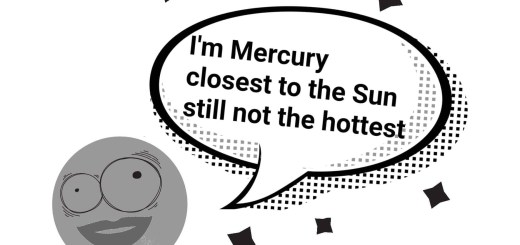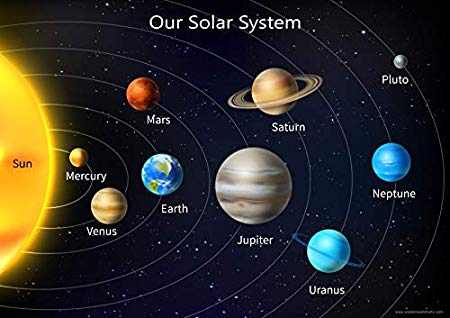The solar system comprises of the Sun, the Earth (where you currently are!), seven other planets, space rocks called asteroids, and comets. Everything in the solar system spins around the Sun. The Sun is a star – a huge wad of hot gas that emits light and warmth.
Mercury

Mercury is the smallest planet in our solar system. It is only slightly bigger than Earth’s moon. It is the nearest planet to the Sun with temperature ranging from -173 degrees Celsius at night to 427 degrees Celsius during the day. Along with Venus, Earth, and Mars, Mercury is a rocky planet, all of which are known as terrestrial planets. It has a solid surface, lined with craters, has a thin atmosphere and does not have any moons.
A day on Mercury isn’t like a day here on Earth. For us, the Sun rises and sets every single day. Mercury has a slow spin and short year and it takes a longer time for the Sun to rise and set there. Mercury has one dawn every 180 Earth days! Isn’t that unusual?
Due to its closeness to the Sun, its average orbital distance is fifty-eight million km (36 million miles) and it has the shortest year (a revolution amount of 88 days). If by any chance you lived on Mercury, you would have a birthday every three months!
Mercury receives the most intense radiation of all the planets. With a radius of 2440 km (1,516 miles), i is that the smallest planet, smaller even than Jupiter’s largest moon, Ganymede, or Saturn’s largest moon, Titan. What’s more, Mercury is denser than other gas giants but less dense than the Earth. A majority of Mercury’s mass is contained in its mostly iron core, roughly 3,600 to 3,800 km wide or around 75% of its diameter. The planet’s rocky outer shell—its surface crust and underlying mantle—is just 500 to 600 km (300 to 400 miles) thick.
The European and Japanese Space agencies’ (ESA – JAXA) two spacecraft under a joint mission called BepiColombo, are on their way to Mercury. Previous missions were NASA’s Mariner 10 and Messenger spacecraft.
Venus
If the Sun were as tall as a commonplace front entryway, the Earth and Venus would each be about the size of a nickel. Venus circles our Sun and is the second closest planet to it, at a separation of around 108 million km (67 million miles). One day on Venus is as long as 243 Earth days and Venus also rotates in reverse, with its Sun rising in the west and setting in the east.
Venus’ surface is volcanic, covered with plains, high volcanic mountains and immense furrowed plateaus. Venus has no moons and no rings. The planet’s surface temperature is around 465 degrees Celsius (900 degrees Fahrenheit) — sufficiently hot to liquefy lead. Many scientists believe that water once existed on the planet.
More than 40 spacecraft have visited Venus. In the 1990s, the Magellan mission mapped the planet’s surface and Akatsuki is currently in orbit around it. We already know that Venus’ extreme temperature and acidic atmosphere make it an unlikely place for life.
Earth
The one aspect that makes Earth extraordinary among the solar system’s planets is that it is the ONLY planet as far as we know which harbours life. In addition to the fact that Earth contains life, it is also extremely rich in biodiversity, all of which is dependent on the water covering its surface. Around 71% of the Earth is covered with salt-water seas. Additionally, Earth’s climate is comprised of mostly nitrogen and oxygen while Venus’ and Mars’ environments are generally made up of carbon dioxide.
Earth has one moon, which you have presumably observed. It is the fifth biggest moon in the solar system. You may feel that the Earth is an ideal circle, yet it is really an oblate spheroid. This is because the equator swells out marginally because of its spin.
It is the fifth biggest out of the eight planets. Small seismic tremors occur somewhere on the Earth all the time. It circles the Sun at a speed of 10,782 km per hour (6700 miles).
Mars
Mars is the fourth planet from the Sun at an average distance of about 228 million km (142 million miles). Its surface is dry and covered with iron minerals and rocks. This is why it looks red when seen from Earth.
Mars has regular massive storms, which are fuelled by the Sun and can send dust for miles around, covering a significant part of the planet. A few are so huge stargazers on Earth can see them. In contrast to Earth, Mars has a thin atmosphere made up of carbon dioxide. Therefore, it is a lot colder (average of – 70 degrees F) than Earth. There is proof that fluid water once existed on the surface of Mars. Maybe there was even life on Mars billions of years ago.
Mars is one of the easiest planets to see from Earth because it is closer and since it is further from the Sun than us, it is easy to see in the night sky. The Mariner 4 rocket was the first to bring us close pictures of Mars in 1965. From that point forward, many spacecraft have visited Mars. The Viking 1, Viking 2, and Pathfinder landers sent us back photos of its surface.
Recently, the Opportunity rover said goodbye after spending almost 15 years on the planet and Curiosity is still moving across its surface, sending back data and pictures. The Insight lander has been there for 130 Sols (days on Mars based on its spin) studying the geology and there are three orbiters around it.
Mars will probably be the first planet that a human will step foot on.
Jupiter
Jupiter is largest planet in the solar system. Eleven Earths could fit across Jupiter’s equator. It orbits around 778 million km (484 million miles) from our Sun. It orbits takes ten hours to spin on its axis (a Jovian day) yet it takes around 12 Earth years to finish one orbit of the Sun (a Jovian year).
Jupiter is a gas giant. Its atmosphere primarily comprises of hydrogen and helium. It has more than 75 moons. In 1979, the Voyager mission found Jupiter’s ring framework. All of the four giant planets in our close planetary system have ring systems.
Nine shuttles have visited Jupiter. Seven flew by and two have orbited around it. Juno, the latest, reached Jupiter in 2016. It is not likely that Jupiter can harbour life. Its Great Red Spot is a massive storm that is about double the span of Earth and has been raging for over a century.
Saturn
Saturn is completely different from Earth. It is a huge planet and nine Earths could fit inside it. It is one of the gas giants and its atmosphere is mostly made up of hydrogen and helium. Saturn’s day of 10.7 hours is a lot shorter than Earth’s, while its year is more than 29 Earth years. It has 60 moons versus Earth’s one moon.
What makes Saturn extraordinary are its unmistakable and beautiful rings, which surround the planet. They are made of pieces of ice and rocks.
When Galileo Galilei saw Saturn through a telescope during the 1600s, he did not know what he was seeing. At first, he thought he was looking at three planets or a planet with handles. Now we know those “handles” are the rings of Saturn.
Uranus

Uranus is the seventh planet from the Sun and is four times wider than the Earth. It is more than twice as far away from the Sun as Saturn. Uranus is an ice giant like its sister planet Neptune. Although it has a gaseous atmosphere, like the gas giants Jupiter and Saturn, a significant part of its mass is comprised of dense icy material.
From Earth we see it as blue-green in color due to the methane in its atmosphere. Uranus has rings like Saturn; however, the inner rings are thin and dull, while the outer ones are bright. It has 27 moons and is the third biggest planet in the Solar System.
Uranus was first termed a planet by the British stargazer William Herschel, who found it using a telescope. Before this Uranus was believed to be a star.
Its atmosphere is comprised of mostly hydrogen gas with some helium and makes up about 25% of the planet. The climate is stormy, however not as dynamic as that of Saturn or Jupiter. The surface of Uranus is genuinely featureless and uniform.
Being so far from the Sun, Uranus is a whole lot colder than Earth. It rotates east to west and on its side. The Sun shines on some parts of Uranus for up to 42 years and after that, it is dark for a long time.
Neptune
Neptune is the eihth nearest planet to the Sun and the distance from the Sun to Neptune is more than 4498.1 million km (2,795 million miles) .
Neptune is one of the four ‘Jovian’ or gas planets. It is comprised of layers and layers of gas and has numerous rings and moons that orbit around it. The average temperature on Neptune is around -392 degrees, which makes it one of the coldest planets in the solar system. Neptune was found in 1846 and can be seen through a telescope.
Neptune’s atmosphere is made of the gas methane, which gives the planet a splendid blue colour. It takes 165 Earth days to circle the Sun. One day on Neptune lasts for around 16 hours, as opposed to Earth’s 24 hours.
Pluto

Until 2006, Pluto was regarded as the ninth planet of the Solar System. After that, the IAU (International Astronomical Union) redefined the term planet and Pluto was demoted to a dwarf planet. It is 40 times as far away from the sun as the Earth and is in a region known as the Kuiper Belt.
Pluto is a little planetoid, smaller than the Earth’s moon. It is suspected that Pluto is comprised of a mantle of ice (mostly Nitrogen ice), which is about half of its mass, and a rough centre, which makes up the other half.
Pluto has a remarkable orbit around the Sun. Instead of a round orbit, like the eight planets, Pluto’s is more egg-shaped. At its nearest point to the Sun, it is around 4.184 billion km (2.8 billion miles) away. At its farthest point, it is around 8. 04 billion km (5 billion miles ) from the Sun. Pluto has a hard, rough surface like the Earth. It is so far away from the Sun, that it gets almost no energy from the Sun and is amazingly cold.
NASA’s New Horizon is the only spacecraft that visited Pluto in 2015 before moving on to other Kuiper Belt objects.

Fatima Zahra is a student of Quaid-e-Azam University Islamabad doing her BS Biochemistry. she is interested in reading suspense stories, creative writing, and also fond of cooking.

